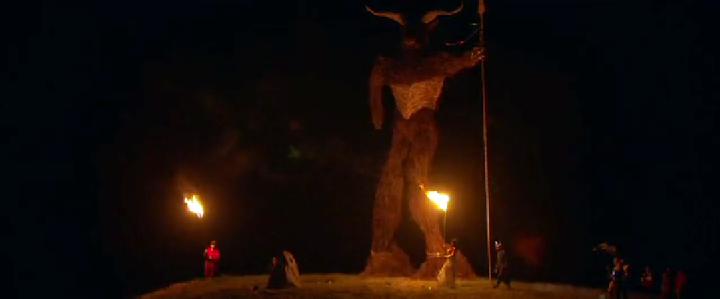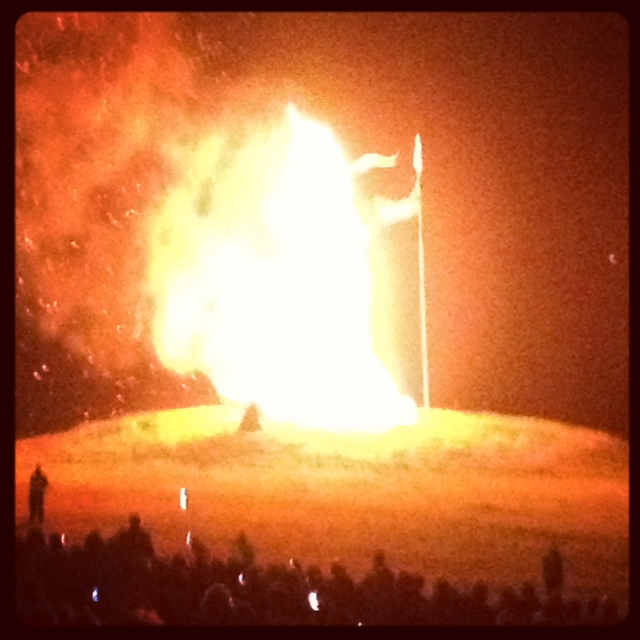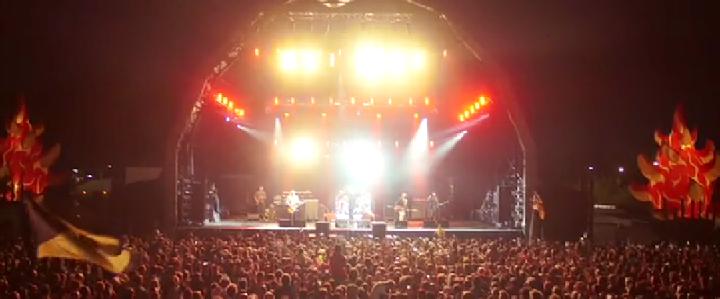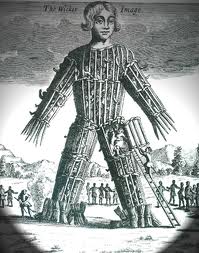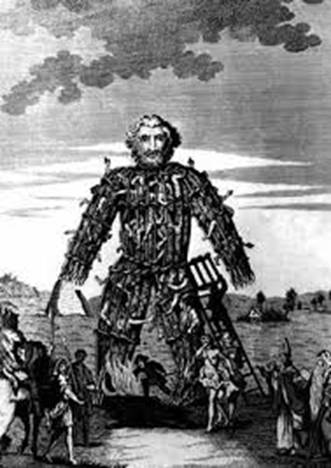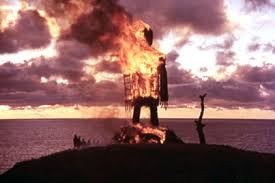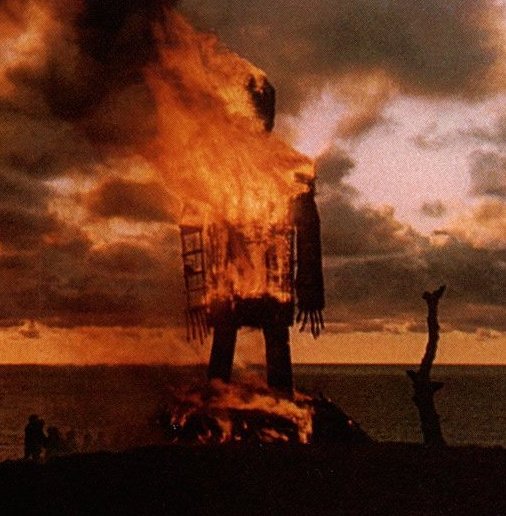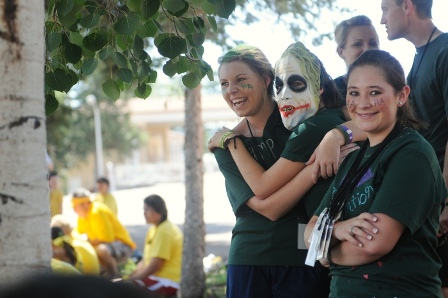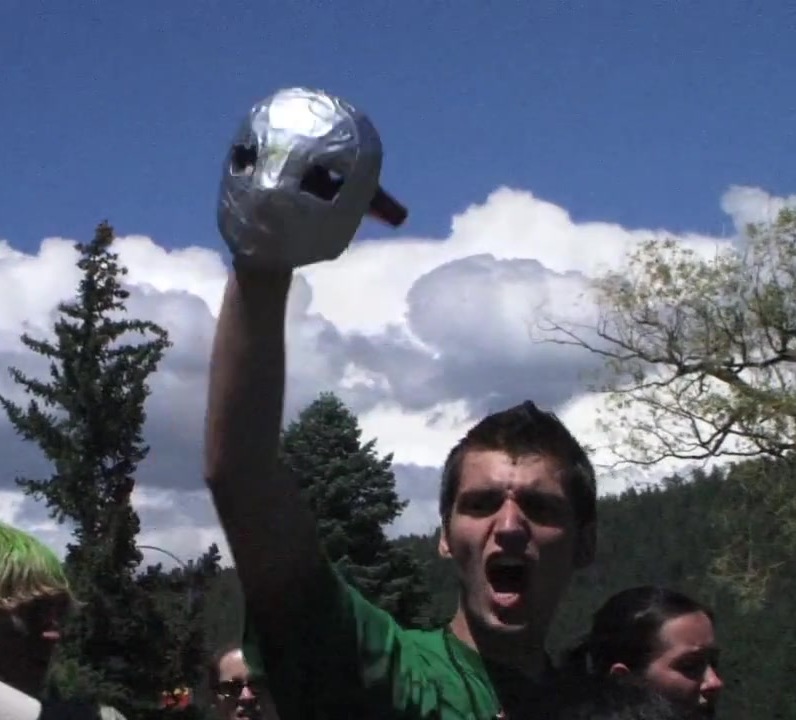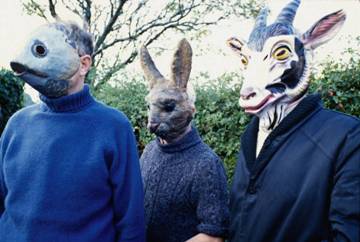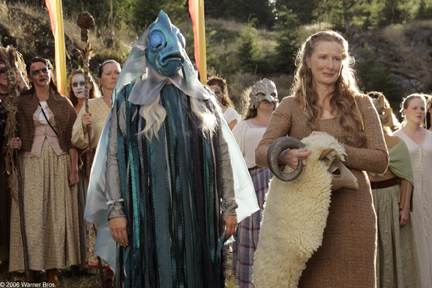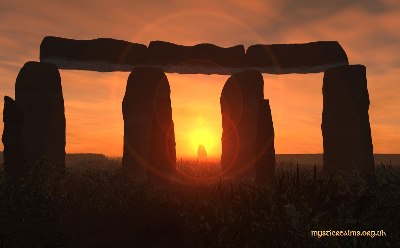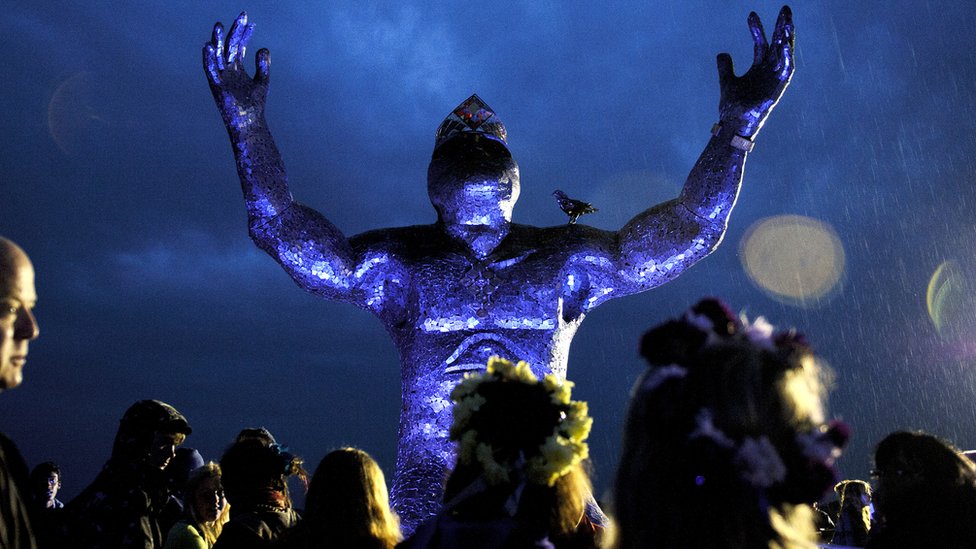JOHN MACARTHUR
MAINSTREAMING PAGANISM IN THE CHURCH
PART 9
THE WICKER MAN
“Again, thou shalt say to the children of Israel, Whosoever he be of the children of Israel, or of the strangers that sojourn in Israel, that giveth any of his seed unto Molech; he shall surely be put to death: the people of the land shall stone him with stones. And I will set my face against that man, and will cut him off from among his people; because he hath given of his seed unto Molech, to defile my sanctuary, and to profane my holy name. And if the people of the land do any ways hide their eyes from the man, when he giveth of his seed unto Molech, and kill him not: Then I will set my face against that man, and against his family, and will cut him off, and all that go a whoring after him, to commit whoredom with Molech, from among their people.” Leviticus 20:2-6
“But whoso shall offend one of these little ones which believe in me, it were better for him that a millstone were hanged about his neck, and that he were drowned in the depth of the sea. Woe unto the world because of offences! for it must needs be that offences come; but woe to that man by whom the offence cometh!” Matthew 18:6-7
John MacArthur’s Regeneration Camp is held each summer during the Druid festival of Lugnasadh. Parents and churches from all over the United States send their adolescent children to Camp Regen. There the young people may be hearing sermons about holiness and separation from the world, but they are also learning and practicing the customs of the heathen. Regeneration Camp games and activities look like harmless fun but they have a most sinister source—the Druid fire festivals of Great Britain. Regen campers may be having fun now, but they are unwittingly traveling a dangerous path on the road to destruction.
“When thou art come into the land which the LORD thy God giveth thee, thou shalt not learn to do after the abominations of those nations. There shall not be found among you any one that maketh his son or his daughter to pass through the fire, or that useth divination, or an observer of times, or an enchanter, or a witch, Or a charmer, or a consulter with familiar spirits, or a wizard, or a necromancer. For all that do these things are an abomination unto the LORD: and because of these abominations the LORD thy God doth drive them out from before thee. Thou shalt be perfect with the LORD thy God.” Deut. 18:9-12
How must God view the spectacle of Christian youth playing “funeral games” on the pagan feast of Lughnasadh––with their faces painted and bodies tattooed, making war cries and playing tug of war around a sacrificed pig’s head, slogging in the mud like swine and displaying the spirit of revelry at pagan rock concerts, etc.? The ultimate funeral game and high point of the Druid festivals, however, is the burning of the Wicker Man, and there were even vestiges of this abomination at the Regeneration and Forest Home youth camps.
According to the Beltane Fire Society, “Our previous Lughnasadh celebrations have often included burning a wicker man, vegan feast, lamb or pig spit-roast, games and challenges, community-focused ritual, usually finished off with some drumming and dancing around a big bonfire.” (beltane.org) In pre-Christian Britain, and even later, a sacrifice was made by fire of one or more human victims in a giant wicker cage made in the image of a giant, that is a Nephilim.
Today there are popular Wicker Man festivals in the British Isles on the Druid feasts. Several Wicker Man festivals were held in the weeks preceding the 2012 London Olympics, which occurred during the Festival of Lughnasadh. For example, a major Wicker Man festival was held in Scotland the week prior to the Olympics and various Wicker Man festivities were held in England and Ireland during the month of July.
Although the horrific Wicker Man sacrifice is alleged to no longer be performed, its memory has been revived and popularized in modern times by film industry––the 1967 British novel, Ritual, the 1973 British horror film, The Wicker Man and more recently in the U.S. with yet another Wicker Man film in 2006 starring Nicholas Cage. The 1973 version of the film was released in British theaters on July 27, 2012, the date of the Olympics Opening, and a scene from the Wicker Man film was shown as part of the ceremony. Exactly one year to the day later, on July 27, 2013, an edited version of the film was released in the U.S.
Forest Home Camp & Retreat Center “Core Values” begins with the Mission Statement “Encounter Jesus. Experience Transformation. Engage the World.” Forest Home’s “Vision” is “to partner with the Church to create a revolutionary Christ-centered experience in which people of all ages... connect with God through His creation.” Connecting with God through His creation is pantheism. “Pantheism, and the worship of nature...lay at the root of all pagan idolatries.” (Fausset’s Bible Dictionary) Pantheism and nature worship are condemned by God in Romans 1:23-25:
“Professing themselves to be wise, they became fools, And changed the glory of the uncorruptible God into an image made like to corruptible man, and to birds, and fourfooted beasts, and creeping things. Who changed the truth of God into a lie, and worshipped and served the creation more than the Creator.”
The “Core Values” of Forest Home require, not Bible study, but innovative, revolutionary thinking: “Dream Big,” “Think outside the box,” and “Dream, plan and execute new ideas.” This is the transformational, New Age language of the church growth movement which is transforming churches into centers of pagan worship. This is being done by subtly introducing elements of pagan worship to church programs for children through adults.
Forest Home’s High School Summer Camp 2013 was titled “Woven,” a term referring to Celtic knots, a woven art style peculiar to the Celts. “Woven” may also be a subtle allusion to the Wicker Man which is peculiarly Celtic. Subtle allusions to pagan concepts are cleverly embedded in Forest Home and Regeneration Camp photos and promos.
*Forest Home Summer Camp Promo*
From: The Wicker Man: A Ritual of Transformation
“Rites of Spring 1982: a circle of witches gathers at twilight in a familiar clearing in the southern New Hampshire woods. They come deliberately in four lines from the cardinal directions singing their invocations to the beat of a lone drum. Only moments before, the members of each line had formed their own circle, chanting together and calling the energy and power of one direction, one element, to be with them. Now, wearing colored ribbons (yellow for air, red for fire, blue for water, and green for earth) the four lines merge in a circle surrounding a human-like figure woven of reeds and grasses that stands at the center.
“The chanting voices weave together as do the dancers, until the movement suddenly stops, each group in its quarter. Now the celebrants turn their attention inward. The elemental chants shift into a chant to the moon. Silence. A voice calls them to sink into the earth, to be connected with Her. Quietly, those assembled there recall the arrogance and thoughtlessness with which humans live on the earth-wasting their Mother's riches, destroying and polluting Her body. They recall how they themselves have done so. Remembering and mourning, they shape a wish that these things be changed. A robed priestess moves to the center and addresses the image, naming it the embodiment of destructive human thoughtlessness. Now the group invokes fire, not as hatred or destruction, but as the endless process of change and transformation that moves through all things. The figure stands silent as the first small flickerings catch and spread. Quickly, the early evening darkness is ablaze as the figure is engulfed in flame.” (The Wicker Man: A Ritual of Transformation)
WICKER BOY
At Forest Home’s High School Summer Camp 2013, a boy covered with mud, leaves and branches represents the spirit of vegetation. Youth at Forest Home Camp are “connecting with the earth,” not to God, by learning the customs of the heathen.

*Forest Home Summer Camp Promo*
Wicker boy fits the description of the human victim in a Beltane fire sacrifice described by James Frazer in The Golden Bough:
“And at the Beltane fires the pretended victim was seized, and a show made of throwing him into the fire, and for some time afterwards people affected to speak of him as dead. In the following customs Mannhardt is probably right in recognising traces of an old custom of burning a leaf-clad representative of the spirit of vegetation. At Wolfeck, in Austria, on Midsummer Day, a boy completely clad in green fir branches goes from house to house, accompanied by a noisy crew, collecting wood for the bonfire. As he gets the wood he sings— ‘Forest trees I want, No sour milk for me, But beer and wine, So can the wood-man be jolly and gay.’
“In some parts of Bavaria, also, the boys who go from house to house collecting fuel for the midsummer bonfire envelop one of their number from head to foot in green branches of firs, and lead him by a rope through the whole village. At Moosheim, in Würtemberg, the festival of St. John’s Day Fire usually lasted for fourteen days, ending on the second Sunday after Midsummer Day. On this last day the bonfire was left in charge of the children, while the older people retired to a wood. Here they encased a young fellow in leaves and twigs, who, thus disguised, went to the fire, scattered it, and trod it out. All the people present fled at the sight of him. But it seems possible to go farther than this.
James Fraser then described the horrific reality of the Celtic Beltane festivities... human sacrifices by fire:
“Of human sacrifices offered on these occasions the most unequivocal traces, as we have seen, are those which, about a hundred years ago, still lingered at the Beltane fires in the Highlands of Scotland, that is, among a Celtic people who, situated in a remote corner of Europe, enjoying practical independence, and almost completely isolated from foreign influence, had till then conserved their old heathenism better than any other people in the West of Europe. It is significant, therefore, that human sacrifices by fire are known, on unquestionable evidence, to have been systematically practised by the Celts.” (James Frazer, The Golden Bough, Vol. 2, pp. 745-7)
See: *Scotland's Wicker Man Festival, Lughnasadh July 26-27, 2013*
THE WICKER MAN CARNIVAL
John MacArthur’s Grace Community Church sponsors a “Carnival” each summer at which the children’s faces are painted like pagans do for their rituals. (See: Part 7) Traditionally, the Celtic “Carnival” featured a 40-50 foot Wicker giant containing many human beings who were sacrificed:
“At Dunkirk the giant is forty to fifty feet high, being made of basket-work and canvas, properly painted and dressed. It contains a great many living men within it, who move it about. Wicker giants of this sort are common in the towns of Belgium and French Flanders; they are led about at the Carnival in spring.” (James Frazer, The Golden Bough, Vol. 2, p. 281)
“Since early times carnivals have been accompanied by parades, masquerades, pageants, and other forms of revelry that had their origins in pre-Christian pagan rites, particularly fertility rites that were connected with the coming of spring and the rebirth of vegetation. One of the first recorded instances of an annual spring festival is the festival of Osiris in Egypt; it commemorated the renewal of life brought about by the yearly flooding of the Nile. In Athens, during the 6th cent. B.C., a yearly celebration in honor of the god Dionysus was the first recorded instance of the use of a float. It was during the Roman Empire that carnivals reached an unparalleled peak of civil disorder and licentiousness. The major Roman carnivals were the Bacchanalia, the Saturnalia, and the Lupercalia. In Europe the tradition of spring fertility celebrations persisted well into Christian times, where carnivals reached their peak during the 14th and 15th cent. Because carnivals are deeply rooted in pagan superstitions and the folklore of Europe, the Roman Catholic Church was unable to stamp them out and finally accepted many of them as part of church activity. The immediate consequence of church influence may be seen in the medieval Feast of Fools, which included a mock Mass and a blasphemous impersonation of church officials.” (Pagan Revelry: The Days Are Evil)
|
Sunday, August 01, 2010 [Festival of Lughnasadh] Summer Family Fest: Campus Carnival 7:30 PM - 10:00 PM Location: Campus-wide Ministry: Children’s Ministry This summer Sunday-evening event has become a family favorite. Join us after the evening service for a great time of games, food, and fun. Activities for all ages and interests will be available across the campus. Summer Family Fest: Building the Family One Blast at a Time |
THE WICKER MAN SACRIFICE
In The Golden Bough, James Frazer cited Julius Caesar’s written observations of the Celtic tradition of human sacrifices in his Commentarii de Bello Gallico (Commentary on the Gallic War):
“The earliest description of these sacrifices is by Julius Caesar. As conqueror of the hitherto independent Celts of Gaul, Caesar had ample opportunity of observing the national Celtic religion and manners, while these were still fresh and crisp from the native mint and had not yet been fused in the melting-pot of Roman civilisation. With his own notes Caesar appears to have incorporated the observations of a Greek explorer, by name Posidonius, who travelled in Gaul about fifty years before Caesar carried the Roman arms to the English Channel. The Greek geographer Strabo and the historian Diodorus seem also to have derived their descriptions of the Celtic sacrifices from the work of Posidonius, but independently of each other and of Caesar, for each of the three derivative accounts contains some details which are not to be found in either of the others. By combining them, therefore, we can restore the original account of Posidonius with some certainty, and thus obtain a picture of the sacrifices offered by the Celts of Gaul at the close of the second century b.c.
“The following seem to have been the main outlines of the custom. Condemned criminals were reserved by the Celts in order to be sacrificed to the gods at a great festival which took place once in every five years. The more there were of such victims, the greater was believed to be the fertility of the land. When there were not enough criminals to furnish victims, captives taken in war were sacrificed to supply the deficiency. When the time came the victims were sacrificed by the Druids or priests. Some were shot down with arrows, some were impaled, and some were burned alive in the following manner. Colossal images of wicker-work or of wood and grass were constructed; these were filled with live men, cattle, and animals of other kinds; fire was then applied to the images, and they were burned with their living contents.” (p. 279)
Lady Gaga as “Wicker Lady” at the 2009 MTV Music Awards
In the year 2000, a British heavy metal band, the Iron Maiden, released an album titled Brave New World which included a song about “The Wicker Man.” Inspired by the 1973 British film Wicker Man and the legend of King Arthur, the lyrics of “The Wicker Man” take up the theme of Tennyson’s poem, “Morte D’Arthur”––The Once and Future King. The lyrics reveal that the fiery Wickerman sacrifice of human beings is an invocation of the dead Celtic kings, King Arthur and his Druid Knights, who await their return to rule the world.
“The Wicker Man”
“When the dying western sun dips low
And the raincloud rises in the east
Between the lines of truth and the words of faith
Lie the fiery duties of the priest
Stir the blood of ancient things
Drawing down the moon
“From the hill of Tara see the beltane fires
And the silent Celtic kings await
From the midnight hour to the light of dawn
Feel the mountain tremble and your heart will shake
“Stir the memories of the stones
We are drawing down the moon
In the circle of the old ways
Of the wicker man...Wicker Man, wicker man
From the beacon hill,
cast your fire on this land...“Morte D’Arthur”
...and the moon was full.
Then spake King Arthur to Sir Bedivere:
...I perish by this people which I made,––
Tho' Merlin sware that I should come again
To rule once more––but let what will be, be,...
“So saying, from the ruin’d shrine he stept
And in the moon athwart the place of tombs,
Where lay the mighty bones of ancient men,
Old knights, and over them the sea-wind sang
Shrill, chill, with flakes of foam.He, stepping down
By zigzag paths, and juts of pointed rock,
Came on the shining levels of the lake.“There drew he forth the brand Excalibur,
And o'er him, drawing it, the winter moon,
Brightening the skirts of a long cloud, ran forth
And sparkled keen with frost against the hilt...Animal masks were an integral part of the Wicker Man festival. They are prominently visible in the 1973 British horror film, The Wicker Man and the Wicker Man film in 2006 starring Nicholas Cage. The purpose of wearing animal masks is to transform the mental state of participants into animals who nevertheless believe they are gods:
“A person in a mask is no longer themselves; they take on the persona of the mask. Their own face is hidden and the consequent freedom of this was exploited during masked balls and carnivals when people could behave as they normally would not. Masks have been used for ritual purposes for thousands of years. There are ancient cave paintings depicting humans wearing animal masks and horns. When a priest or performer dons a mask of the god, he becomes the god. When a shaman or warrior dons the mask of an animal, he becomes that animal.” (Mason and Franklin, Lughnasa: The Eight Festivals)
“Lughnasadh is the perfect time to experiment with the use of masks. Wearing a mask allows the person to hide their own face and personality, and don the personality of the mask. Wear the mask of your totem, or of your god/goddess. Become the mask you make.” (Lughnasadh: Activities at Lammas)
Animal masks are also worn by campers at John MacArthur’s Regeneration, which took place during the Druid festival of Lugnasadh, which is also the Celtic Druid “Festival of Regeneration.”
*Regeneration Summer Camp Promo*
*Regeneration Summer Camp Promo*
The Wicker Man Film (2006)
The Wicker Man Film (2006)
According to pagan sources, Celtic warriors wearing animal masks were empowered to “shapeshift” into animals and endued with the physical strength of animals. The animal is also believed to be a guide to the “Otherworld,” i.e. Hell. King Solomon's magical signet ring enabled him to speak with animals:
WORKING WITH ANIMAL SPIRITS
“Warriors often had animal totems or called upon animal powers to help them in battle, invoking the strength of the bull, the courage of the boar, and so on... These warriors were feared, because they knew how to draw on the power and strength of the bear and fought in a kind of tranced frenzy, without fear or hesitation. They received the power of the bear at their initiation and were also believed to be able to shapeshift... certain ancient Celtic warriors were said to be able to turn themselves into wolves to tear and rend their enemies...
“...Perhaps in early times warriors wore animal masks in battle or during their initiations. Worldwide, magicians and shamans work with animal powers. The qualities of the animal are called upon to help the magician in his or her work... Because the animal is a spirit, it is also a guide to the Otherworld.” (Lammas: Celebrating the Fruits of the First Harvest, p. 156)
“The protagonists of Celtic myth often transformed themselves into animals. The interest in magical transformation among the Celts may be rooted in a feeling for the fluidity of the cosmos-the malleability of the boundaries between this world and the next. Movement between the mortal world and the Otherworld was thought to take place at certain special times of year. In Irish myth, the hero Oengus assumed the form of a swan to follow his lover into the Otherworld on the feast of Samhain, when the barriers between the two realms were at their most fluid.” (“The Mystery of Celtic Cultural Legacy: Magic and Metamorphosis”)
“The magical signet ring said to have been possessed by King Solomon, which variously gave him the power to command demons and to speak with animals, as we saw above was carved with the Name of God, and set with four jewels. In later versions the ring bore the symbol of the hexagram.” (Notes on Le Serpent Rouge)
A banner of the Masonic Skull & Crossbones was flown high at the 2013 Regeneration Camp.
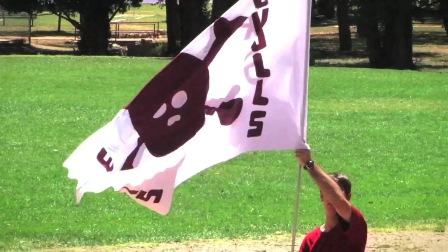
*Regeneration Summer Camp Promo*
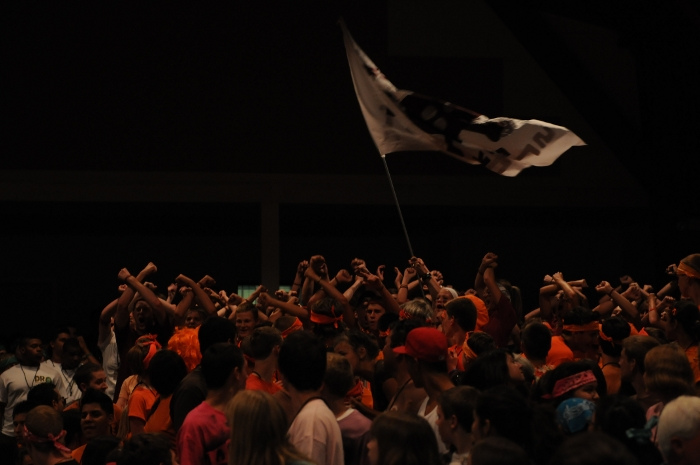
The Skull & Crossbones is prominent in Scotland where Scottish Rite Freemasonry was instituted before it was exported around the world.
“According to later Freemasonic writers, the skull-and-crossbones was long associated with both the Templars and with the murdered Master... During the seventeenth and eighteenth centuries, the skull-and-crossbones was used as a device to denote Hiram’s grave—and, by extension, the grave of any Master Mason... The skull-and-crossbones was also an important part of the regalia of the Freemasonic degree known as ‘Knight Templar’ and it figures prominently at Kilmartin and elsewhere in Scotland, along with other Masonic emblems.” (The Temple & The Lodge, pp. 129-130)
The Order of Skull & Bones also called the “Brotherhood of Death” derives its name from this symbol of human sacrifice:
“Secret Societies such as the Freemasons, Skull and Bones and Illuminati regularly engage in very specific ritualistic ceremonies and practices which are used to call up the various dark entities or ‘gods‘ that they worship. The elite believe that this is the source from where much of their knowledge and power is obtained. Much of the elite (bloodlines) believe that they are actually direct descendents of these ‘gods’. While it’s true that some of their knowledge and power is gained this way, the actual process is mostly reversed with the dark entities drawing from the energy that is freely given to them during various rituals and ceremonies.... Large gatherings of people who engage (knowingly or unknowingly) in ritualistic practices, provide very high concentrations of energy which help make them stronger.” (2012 Olympics: Occult Symbolism & Mind Programming)
“Invisible Empire: Skull & Bones, Bohemian Grove, Pagan Ritual” (video removed)
MOLOCH / BAAL: THE SUN-GOD
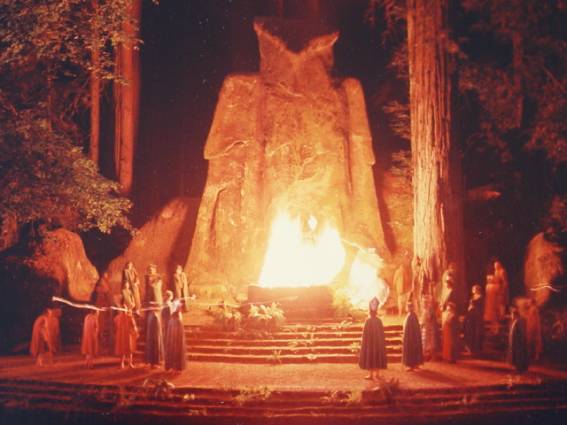
40 ft. Great Owl (Moloch)
Seventy miles north of San Francisco, California lies the Bohemian Grove, a secluded reserve where 2700 members of the Bohemian Club gather annually during the last two weeks of July. This period is the Celtic Druid festival of Lugnahsadh. At the Bohemian Grove, Druidic rituals which include human sacrifice are reportedly conducted by high officials of the U.S. government, media and business. According to Antony Sutton, Moloch is the god worshipped at the Bohemian Grove:
“For decades, there have been vague rumors of weird goings on in Bohemian Grove in more remote parts of its 2200 acres. Reliable reports claim Druidic like rituals, druids in red hooded robes marching in procession and chanting to the Great Owl (Moloch.) A funeral pyre with ‘corpses.’ (Scores of men work in the Bohemian Grove as servants so this party is fairly well established.)
“An article in a local community newspaper, Santa Rosa Sun (1993, July) reported on the Cult of Canaan and the legend of Moloch in place at Bohemian Grove. The Moloch Pagan Cult of Sacrifice is human sacrifice. About the mid 1980s there were rumors of murders in remote parts of the property. A local police investigation went nowhere. State investigators on related criminal acts went nowhere.” (“Bohemian Grove & Global Elite”)
There are other groves in Europe akin to the Bohemian Grove. One Celtic Druid grove draws former Nazis, such as Albert Huber, a crypto-Jew who converted to Islam and works with the Thule Society. Huber also belongs to a group called “Avalon” (burial place of King Arthur) based on the ‘Great Celtic tradition’ of human sacrifice that inspired Stonehenge:
“Ahmed (Albert) Huber [is] a neo-Nazi, and a former journalist who converted to Islam, and changed his first name from Albert... Huber is also a member of a group calling itself Avalon, which claims to be based on the ‘Great Celtic tradition’, and at every solstice he meets under the moon, in a forest grove, with a few hundred European Druids, with whom he is preparing the ‘End of Our Decline.’ With the Thule Society, he works for the restoration of “Greater Germany’. (Black Terror, White Soldiers, David Livingstone, p. 553)
There are eight feasts of the Druidic calendar, the major feasts being Lughnasadh (August 1), Samhain (October 30-31), Imbolc (February 1-2) and Beltane (April 30-May 1). These cross-quarter feasts, along with the summer and winter solstices and spring and autumn equinoxes are referred to as Sabbats:
The eight-armed sun cross represents the Pagan Wheel of the Year.
“The festivals are also referred to as sabbats /ˈsæbət/, the term being explained as passed down from the Middle Ages, when the terminology for Jewish Shabbats was commingled with that of other heretical celebrations. See Witches' Sabbath.” (Wheel of the Year)
In other words, the Druidic Sabbat festivals have their origin in the pagan rites of the apostate tribes of Israel, who worshipped Baal and Molech, the good and bad powers of the Sun-god, who are devils that require human sacrifice.
“And they shall no more offer their sacrifices unto devils, after whom they have gone a whoring. This shall be a statute for ever unto them throughout their generations.” Leviticus 17:7
There is ample evidence in the Old Testament of human sacrifices ritually offered to devils throughout all of Israel:
“And it came to pass, as soon as Gideon was dead, that the children of Israel turned again, and went a whoring after Baalim, and made Baalberith their god.” Judges 8:33
“” (1 Kings 11:7-8)
“(2 Kings 17:16-18)
“ (Jeremiah 32:35)
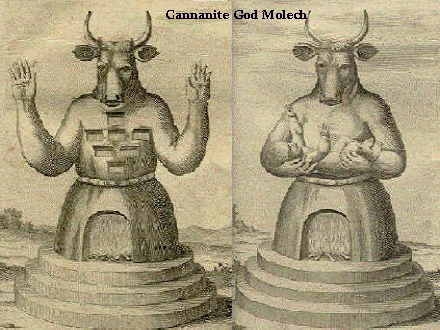
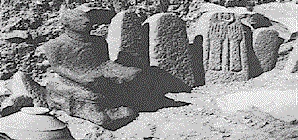
All eight of the Druid sabbats are paganized Jewish Sabbaths during which fire festivals are held in honor of the Sun god. Beltane is the Druidic feast of Bel or Baal, who is believed to rise from the underworld on that day.
“The sun, the giver and vivifier of all life, was the primary god of antiquity, being worshipped by Assyrians, Chaldeans, Phoenicians, and Hebrews under the name of Baal or Bell, and by other nations under other names. The priests of Baal always held a high position in the State. As the sun was his image or symbol in heaven, so fire was his symbol on earth, and hence all offerings made to Baal were burned or made to pass through the fire, or were presented before the sun. Wherever, in the worship of any nation, we find the fire element, we may at once suspect that there we have a survival of ancient sun-worship. The moon was regarded as a female deity, consort of the sun or Baal, and was worshipped by the Jews under the name of Ashtoreth, or Astarte. Her worship was of the most sensual description. The worship of sun and moon formed one system, the priests of the one being also priests of the other.” (Joseph Jacobs, Folklore of Europe Anthology, 2009)
“The worship of sun and moon formed one system, the priests of the one being also priests of the other.” This explains why Elijah slew the 450 prophets of Baal with no mention of the 400 prophets of Asherah; the 450 were the prophets of Baal-Asherah:
“‘Now therefore, send and gather all Israel to me on Mount Carmel, the four hundred and fifty prophets of Baal, and the four hundred prophets of Asherah, who eat at Jezebel’s table.’...
“And Elijah said to them, ‘Seize the prophets of Baal! Do not let one of them escape!’ So they seized them; and Elijah brought them down to the Brook Kishon and executed them there.” 1 Kings 18:19, 40 (NKJV)
The Babylonian Talmud which is the bible of modern Judaism, permits the sacrifice of children to Moloch:
Blood Ritual
3: Human Sacrifice, the Talmud, and the Moloch ProblemMISHNAH. HE WHO GIVES OF HIS SEED TO MOLECH INCURS NO PUNISHMENT UNLESS HE DELIVERS IT TO MOLECH AND CAUSES IT TO PASS THROUGH THE FIRE. IF HE GAVE IT TO MOLECH BUT DID NOT CAUSE IT TO PASS THROUGH THE FIRE, OR THE REVERSE, HE INCURS NO PENALTY, UNLESS HE DOES BOTH.
— Babylonian Talmud, Tractate Sanhedrin 64a
Soncino 1961 Edition, page 437Following the Mishnah is a discussion among the sages. One of the Talmud Sages, Rabbi Ashi, comments as follows:
GEMARA. R. Ashi propounded: What if one caused his blind or sleeping son to pass through, (3) or if he caused his grandson by his son or daughter to pass through? — One at least of these you may solve. For it has been taught: [Any men … that giveth any of his seed unto Molech; he shall he put to death … And I will set my face against that man, and will cut him off from among his people;] because he hath given of his seed unto Molech. Why is this stated? — Because it is said, there shall not be found among you any one that maketh his son or his daughter to pass through the fire. From this I know it only of his son or daughter. Whence do I know that it applies to his son's son or daughter's son too? From the verse, [And if the people of the land do any ways hide their eyes from the man] when he giveth of his seed unto Molech [and kill him not: Then I will … cut him off.]
— Babylonian Talmud, Tractate Sanhedrin 64b
Soncino 1961 Edition, page 439Rabbi Dr. Freedman, one of the translators of the Soncino Tractate Sanhedrin, clarifies the passage. In a footnote, Rabbi Dr. Freedman confirms that the Talmud Sages use "seed" to denote living children, in the same sense as the Biblical translators understand the term in the above Biblical quotes. In this footnote, Rabbi Dr. Freedman paraphrases the question from Rabbi Ashi:
- Is 'thou shalt not cause to pass' applicable only to a son who can naturally pass through himself, but not to a blind or sleeping son, who must be led or carried, or does it apply to all?
— Rabbi Dr. Freedman
Other footnotes within the same context clarify the fine point of distinction being drawn in the Mishnah and subsequent debates among the sages:
- Lev. XVIII, 21. This proves that the offence consists of two parts; (i) formal delivery to the priests, and (ii) causing the seed to pass through the fire.
— Rabbi Dr. Freedman
- As two separate offences, proving that giving one's seed to Molech is not idolatry. The differences [sic] is, that if one sacrificed to Molech, or caused his son to pass through the fire to some other deity, he is not punished.
— Rabbi Dr. Freedman
Following the Mishnah, Sanhedrin 64a and 64b contain a rousing debate between the Sages concerning:
- the circumstances under which worshipping an idol is idolatry,
- which idols may be worshipped without indulging in idolatry,
- which parts of child sacrifice in what combination are punishable, and
- how children may be sacrificed without violating Leviticus.
Interested students should look up Sanhedrin 64a and 64b and read the entire text, including footnotes. The complete version of Come and Hear™ contains Sanhedrin 64a-64b at htp://www.come-and-hear.com/sanhedrin/sanhedrin_64.html. For those to whom Tractate Sanhedrin is not available, the relevant text is included in the Appendix: Extract from Sanhedrin 64a and 64b.
Ignatius Donnelly’s tome, Atlantis, the Antediluvian World (1882), identifies the religion of Atlantis as Sun worship, and the various gods of the pagan world, including Bel/Baal and Moloch, as Sun gods:
“The Babylonian trinity was composed of Idea, Anu, and Bel. Bel represented the sun, and was the favorite god. Sin was the goddess of the moon. The Phœnicians were also sun-worshippers. The sun was represented by Baal-Samin, the great god, the god of light and the heavens, the creator and rejuvenator.
“The attributes of both Baal and Moloch (the good and bad powers of the sun) were united in the Phœnician god Melkart, ‘king of the city,’ whom the inhabitants of Tyre considered their special patron. The Greeks called him ‘Melicertes,’ and identified him with Hercules...
“The Egyptians worshipped the sun under the name of Ra; the Hindoos worshipped the sun under the name of Rama; while the great festival of the sun, of the Peruvians, was called Ray-mi.” (pp. 284-285)
Why did the Israelites sell their birthright for this mess of pagan pottage? Unger’s Bible Dictionary discovers the reason: pagan rituals were licentious orgies and apostate Israel loved the carnal pleasures of sin rather than the spiritual beauty of holiness.
“Baal, a common Canaanite word for ‘master’, ‘lord,’ was one of the chief male deities of the Canaanite pantheon…. Baal was the son of El, the father of the gods and the head of the Canaanite pantheon… Baal was thus the farm god who gave increase to family and field, flocks and herds. He was likewise identified with the storm-god Hadad whose voice could be heard in the reverberating thunder that accompanied rain, which was so necessary for the success of the crops. The inhabitants of Canaan were addicted to Baal worship, which was conducted by priests in temples and in good weather outdoors in fields and particularly on hilltops called ‘high places.’ The cult included animal sacrifice, ritualistic meals, and licentious dances. Near the rock altar was a sacred pillar or massebah, and close by the symbol of the asherah, both of which apparently symbolized human fertility. High places had chambers for sacred prostitution by male prostitutes and sacred harlots. The gaiety and licentious character of Baal worship always had a subtle attraction for the austere Hebrews bound to serve a holy God under a rigorous moral code.” (Unger, p. 413)
And so it is today.
“In mid-June every year thousands of people travel to ancient religious sites, such as Stonehenge and Avebury in England, in order to see the sun rising on the first morning of summer. The Summer Solstice is also known as Litha and is an important festival day for many modern pagans... For some pagans the Summer Solstice marks the marriage of the God and Goddess, they see their union as the force that creates the harvest’s fruits.
“To mark the Summer Solstice in 2010, a seven tonne steel statue named ‘Ancestor’ was created and erected near the stones. The 22ft (6.70m) figure took nine months to create out of thousands of hand-cut pieces of steel. It returned to the site for the 2012 celebrations.” (Summer Solstice celebrations at Stonehenge)
“ANCESTOR”
THE NEPHILIM
The “Sacred Marriage of the God and Goddess” refers to intermarriage between fallen angels and human females which in times past produced a demonic race which God destroyed in the Great Flood. This demonic race was called Nephilim from the Hebrew word, nephiyl which is derived from naphal which means “fallen” and refers to the angels who left their first estate in Heaven. Today this fallen angelic race is called the Merovingian bloodline or the Grail race:
“The Nephilim were banished to the center of the earth for disobeying God by mating with the daughters of men and teaching them the ‘forbidden’ arts. In this publication the Nephilim have been identified as the Fathers of the Merovingians...
“...the Merovingian race was sired by a water beast known as the Quinotaur. This Quinotaur took the form of a sea-bull. Crowley’s personal seal was of a sea goat. Grant, writing of Crowley’s Seal of the Beast, says: ‘The beast is the sea-goat or amphibious monster identical with Cthulhu, the Quinotaure or Bull of the Deep.’ Grant writes as a footnote; ‘The waters under the earth; home of the ‘ancestors’ or subconscious atavisms of the race.’ Is this a reference to the race of the Grail?” (“Kenneth Grant and the Merovingian Mythos”)
“And it came to pass, when men began to multiply on the face of the earth, and daughters were born unto them, That the sons of God saw the daughters of men that they were fair; and they took them wives of all which they chose. And the LORD said, My spirit shall not always strive with man, for that he also is flesh: yet his days shall be an hundred and twenty years.
“There were giants in the earth in those days; and also after that, when the sons of God came in unto the daughters of men, and they bare children to them, the same became mighty men which were of old, men of renown. And GOD saw that the wickedness of man was great in the earth, and that every imagination of the thoughts of his heart was only evil continually.” Gen. 6:1-5Young’s Literal Translation translates nephiyl as fallen ones:
“The fallen ones were in the earth in those days, and even afterwards when sons of God come in unto daughters of men, and they have borne to them—they are the heroes, who, from of old, are the men of name.”
The MacArthur Study Bible commentary deceptively states that the “giants” of verse 4 were not the offspring of the human-angelic union in verses 1-2 and gives the absurd explanation they were “strong men who fell on others in the sense of overpowering them”:
“The word nephilim is from a root meaning to fall, indicating that they were strong men who fell on others in the sense of overpowering them (the only other use of this term is in Num. 13:33). They were already in the earth when the ‘mighty men’ and ‘men of renown’ were born. The fallen ones are not the offspring from the union in 6:1,2.”
Numbers 13:33 states that the giants were “the sons of Anak, which come of the giants.”
“And there we saw the giants, the sons of Anak, which come of the giants: and we were in our own sight as grasshoppers, and so we were in their sight.” Num. 13:33
MacArthur’s commentary on the “giants” in Numbers 13:33 states: “This term was used in Gen. 6:4 for a group of strong men who lived on the earth before the Flood. The descendants of Anak were, in exaggeration, compared to these giants, which led the spies to view themselves as grasshoppers before them.”
MacArthur’s interpretation is shown to be false by proper exposition of the passage:
“Verse 4 is sadly interesting. The Hebrew for giants is nephilim (RV), which means fallen ones, and in the judgment of some refers to the sons of God or fallen angels of the preceding verses. A slightly different punctuation makes the verse read thus: ‘There were nephilim [fallen ones] in the earth in those days, and also after that.’ ‘After that’ seems to refer to Numbers 13:31-33, where in the report of the spies to Moses they speak of the men of Canaan as of ‘great stature,’ adding: ‘And there we saw the nephilim, the sons of Anak which come of the nephilim.’ This suggests that the culminating sin of the Canaanites was not different from that of the antediluvians. Observe further that the offspring of these sinful unions became the ‘mighty men which were of old, the men of renown,’ from which possibly the ancients obtained their ideas of the gods and demi-gods of which the classics treat.” (Gray’s Concise Bible Commentary)
“giants. Heb. nephilim. Those mentioned in Gen, 6:4 were all destroyed in the Flood; these came from a second irruption of fallen angels, ‘after that’: i. e. after ‘those days’ = the days of Noah. See Genesis 6:4, and Appendix 23 and 25. See note on Numbers 13:22.
A more complete explanation of ‘sons of god’ and ‘nephilim’ is found in The Companion Bible Notes:
Appendix #23
“‘THE SONS OF GOD’ IN GENESIS 6:2, 6:4.
“It is only by the Divine specific act of creation that any created being can be called ‘a son of God’. For that which is ‘born of the flesh is flesh’. God is spirit, and that which is ‘born of the Spirit is spirit’ (John 3:6). Hence Adam is called a ‘son of God’ in Luke 3:38. Those ‘in Christ’ having ‘the new nature’ which is by the direct creation of God (2Cor 5:17. Eph 2:10) can be, and are called ‘sons of God’ (John 1:13. Rom 8:14,15. 1John 3:1). (*1)
“This is why angels are called ‘sons of God’ in every other place where the expression is used in the Old Testament. Job 1:6; 2:1; 38:7. Ps. 29:1; 89:6. Dan 3:25 (no art.). (*2) We have no authority or right to take the expression in Gen 6:2,4 in any other sense. Moreover, in Gen 6:2 the Septuagint renders it ‘angels’. Angels are called ‘spirits’ (Ps 104:4. Heb 1:7,14), for spirits are created by God.
“That there was a fall of the angels is certain from Jude 1:6.
“The nature of their fall is clearly stated in the same verse. They left their own οικητηριον / oiketerion. This word occurs only in 2 Cor 5:2 and Jude 1:6, where it is used of the spiritual (or resurrection) body.
“The nature of their sin is stated to be ‘in like manner’ to that of the subsequent sins of Sodom and Gomorrha, Jude 1:7.
“The time of their fall is given as having taken place ‘in the days of Noah’ (1 Pet 3:20. 2 Pet 2:7), though there may have been a prior fall which caused the end of ‘the world that then was’ (Gen 1:1,2. 2 Pet 3:6).
“For this sin they are ‘reserved unto judgment’, 2Pe 2:4, and are ‘in prison’, 1Pet 3:19.
“Their progeny, called Nephilim (translated ‘giants’), were monsters of iniquity; and, being superhuman in size and character, had to be destroyed (see Appendix 25). This was the one and only object of the Flood.
“Only Noah and his family had preserved their pedigree pure from Adam (Gen 6:9, see note). All the rest had become ‘corrupt’ (shachath) destroyed [as Adamites]. the only remedy was to destroy it (de facto), as it had become destroyed (de jure). (It is the same word in v. 17 as in vv. 11, 12.) See further under Appendix 25 on the Nephilim.
“This irruption of fallen angels was Satan’s first attempt to prevent the coming of the Seed of the woman foretold in Gen 3:15. If this could be accomplished, God’s Word would have failed, and his own doom would be averted.
“As soon as it was made known that the Seed of the woman was to come through ABRAHAM, there must have been another irruption, as recorded in Gen 6:4, ‘and also after that’ (i.e. after the days of Noah, more than 500 years after the first irruption). The aim of the enemy was to occupy Canaan in advance of Abraham, and so to contest its occupation by his seed. For, when Abraham entered Canaan, we read (Gen 12:6) ‘the Canaanite was then (i.e. already) in the land.’ (Companion Bible Notes)
Appendix #25
THE NEPHILIM, OR ‘GIANTS’ Of Gen 6, &c.
“The progeny of the fallen angels with the daughters of Adam (see notes on Gen 6, and Appendix 23) are called in Gen 6, Ne-phil-im, which means fallen ones (from naphal, to fall). What these beings were can be gathered only from Scripture. They were evidently great in size, as well as great in wickedness. They were superhuman, abnormal beings; and their destruction was necessary for the preservation of the human race, and for the faithfulness of Jehovah’s Word (Ge 3:15).
“This was why the Flood was brought ‘upon the world of the ungodly’ (2 Pet 2:5) as prophesied by Enoch (Jude 1:14).
“But we read of the Nephilim again in Nu 13:33: ‘there we saw the Nephilim, the sons of Anak, which come of the Nephilim’. How, it may be asked, could this be, if they were all destroyed in the Flood? The answer is contained in Gen 6:4, where we read: ‘There were Nephilim in the earth in those days (i.e. in the days of Noah); and also AFTER THAT, when the sons of God came in unto the daughters of men, and they bare children to them, the same became [the] mighty men (Heb. gibbor, the heroes) which were of old, men of renown’ (lit. men of the name, i.e. who got a name and were renowned for their ungodliness).
“So that ‘after that’, i.e. after the Flood, there was a second irruption of these fallen angels, evidently smaller in number and more limited in area, for they were for the most part confined to Canaan, and were in fact known as ‘the nations of Canaan’. It was for the destruction of these, that the sword of Israel was necessary, as the Flood had been before.
“As to the date of this second irruption, it was evidently soon after it became known that the seed was to come through Abraham; for, when he came out from Haran (Gen 12:6) and entered Canaan, the significant fact is stated: ‘The Canaanite was then (i.e. already) in the land.’ And in Gen 14:5 they were already known as ‘Raphain’ and Emim’, and had established themselves at Asteroth Karnaim and Shaven Kiriathaim.
“In chapter 15:18-21 they are enumerated and named among Canaanite Peoples: ‘Kenites, and the Kenizzites, and the Kadmonites, and the Hittites, and the Perizzites, and the Rephaims, and the Amorites, and the Girgashites, and the Jebusites’ (Gen 15:19-21; cp. Exodus 3:8,17; 23:23. Deut 7; 20:17. Joshua 12:8).
“These were to be cut off, and driven out, and utterly destroyed (Deut 20:17. Jos 3:10). But Israel failed in this (Joshua 13:13; 15:63; 16:10; 17:18. Judges 1:19,20,28,29,30-36; 2:1-5; 3:1-7); and we known not how many got away to other countries to escape the general destruction. If this were recognized it would go far to solve many problems connected with Anthropology.
Note: This accounts for the presence of Nephilim in the mythologies of various countries all over the world. For example, the Tuatha de Danaan in Celtic Britain, whose illustrious heroes included the god Lugus, who was worshipped during the Festival of Lughnasadh. According to Steve Quayle, author of Giants on the Earth:
“The Tuatha de Danaan: This was a race of Celtic giants and father gods. Like the Cainites and other giants, they were said to dwell in underground kingdoms or inside hollow mountains. One of the chief deities was Lugus, a name that translates to ‘Shining One’, revealing an astonishing connection to Sumer’s deified giant kings.”
“As to their other names, they were called Anakim, from Anak which came of the Nephilim (Num 13:23), and Rephaim, from Rapha, another notable one among them. From Deut 2:10, they were known by some as Emim, and Horim, and Zamzummim (v. 20, 21) and Avim, &c.
“As Rephaim they were well known, and are often mentioned: but, unfortunately, instead of this, their proper name, being preserved, it is variously translated as ‘dead’, ‘deceased’, or ‘giants’. These Rephaim are to have no resurrection. This fact is stated in Isa 26:14 (where the proper name is rendered ‘deceased,’ and v. 19, where it is rendered ‘the dead’). It is rendered ‘dead’ seven times (Job 26:5. Ps 88:10. Pr 2:18; 9:18; 21:16. Isa 14:8; 26:19). It is rendered ‘deceased’ in Isa 26:14.
“It is retained as a proper name ‘Rephaim’ ten times (two being in the margin). Gen 14:5; 15:20. Joshua 12:15 (marg.). 2 Sam 5:18,22; 23:13.& b31 nbsp; 1Chron 11:15; 14:9; 20:4 (marg.). Isa 17:5. In all other places it is rendered ‘giants’, Gen 6:4; Num 23:30, where it is Nephilim; and Job 16:14, where it is gibbor (Appendix 14. iv). By reading all these passages the Bible student may know all that can be known about these beings.
“It is certain that the second irruption took place before Gen 14, for there the Rephaim were mixed up with the five nations or peoples, which included Sodom and Gomorrha, and were defeated by the four kings under Chedorlaomer. Their principal locality was evidently ‘Ashtaroth Karnaim’; while the Emim were in the plain of Kiriathaim (Ge 14:5).
“Anak was a noted descendant of the Nephilim; and Rapha was another, giving their names respectively to different clans. Anak’s father was Arba, the original builder of Hebron (Gen 35:27. Joshua 15:13; 21:11); and this Palestine branch of the Anakim was not called Arbahim after him, but Anakim after Anak. They were great, mighty, and tall (Deut 2:10,11,21,22,23; 9:2), evidently inspiring the ten spies with great fear (Num 13:33). Og king of Bashan is described in Deut 3:11.
“Their strength is seen in ‘the giant cities of Bashan’ today; and we know not how far they may have been utilized by Egypt in the construction of buildings, which is still an unsolved problem. Arba was rebuilt by the Khabiri or confederates seven years before Zoan was built by the Egyptian Pharoahs of the nineteenth dynasty. See note on Num 13:22.
“If these Nephilim, and their branch of Rephaim, were associated with Egypt, we have an explanation of the problem which has for ages perplexed all engineers, as to how those huge stones and monuments were brought together. Why not in Egypt as well as in ‘the giant cities of Bashan’ which exist, as such, to this day?
“Moreover, we have in these mighty men, the ‘men of renown,’ the explanation of the origin of the Greek mythology. That mythology was no mere invention of the human brain, but it grew out of the traditions, and memories, and legends of the doings of that mighty race of beings; and was gradually evolved out of the ‘heroes’ of Gen 6:4. The fact that they were supernatural in their origin formed an easy step to their being regarded as the demi-gods of the Greeks.
“Thus the Babylonian ‘Creation Tablets’, the Egyptian ‘Book of the dead’, the Greek mythology, and heathen Cosmogonies, which by some are set on an equality with Scripture, or by others adduced in support of it, are all the corruption and perversion of primitive truths, distorted in proportion as their origin was forgotten, and their memories faded away. (Companion Bible Notes)Why would the MacArthur Study Bible conceal the demonic identity of the giants in Genesis 6:4 and Numbers 13:33?
The ancient deluge was a global cataclysm and the memory of this epic event has never been lost on the pagan world, which views the God who judged the corrupted race as an evil demiurge. The great flood is, in fact, the unstated theme of all pagan mythology. Its memory is kept alive by demonic entities who communicate to their initiates the desire of the pre-flood gods of ancient Atlantis to avenge themselves. This secret doctrine—of the lost Atlantis—is then communicated to the pagan subculture by means of initiation rites, mythology, symbolism, kabbalah, numerology, alchemy, astrology, magick and other occult so-called arts and sciences.
Thus the pagan mysteries and agenda are carefully concealed from the uninitiated, who are then misled with false interpretations of Scripture, including the fallen angels, and just about everything else. Whether or not former CIA director William Casey made the following statement in 1981, it describes the superfluity of lies and shortage of truth communicated to the American public.
“We’ll know our disinformation program is complete when everything the American public believes is false.”
“...the vast history of giants...has, for the most part, been kept from the public. Proof of giants’ existence - their skeletal remains - has been quickly secreted away in obscure museums, when not destroyed. Additionally, time has cloaked and sugar-coated these creatures’ true perverse nature, the majority too vile, too demonic for bedtime stories. However, history is replete with their tales of unimaginable cruelty, sexual perversity, cannibalism and pagan rituals.” (Genesis 6 Giants)
Ignatius Donnelly confirms that the basis of Greek mythology and its pantheon of gods and goddesses was based on the superhuman kings that ruled the antediluvian world:
“Sun-worship, as the ancient religion of Atlantis, underlies all the superstitions of the colonies of that country.
“The Greeks, too young to have shared in the religion of Atlantis, but preserving some memory of that great country and its history, proceeded to convert its kings into gods, and to depict Atlantis itself as the heaven of the human race... The history of Atlantis is the key of the Greek mythology...” (Atlantis. Atlantis, the Antediluvian World, p. 285)
According to Tracy Twyman, editor of Dagobert’s Revenge, the ancient pre-flood gods are “dead but dreaming”—that is, dreaming of their glorious return to reclaim their earthly kingdom.
“While figures such as Hermes, Saturn, Hercules, and the others we’ve discussed so far were undoubtedly separate people in history, and were at one time the Kings of Atlantis, because they all had similar titles, attributes and teachings, and ruled over the same global empire, they have gotten blurred together in the mythic consciousness of legend. Thus, the sleeping, half-dead gods who inhabit the subterranean tombs of Saturn, Satan, Hermes, Hercules, and even Christian Rosenkreutz (as an embodiment of Osiris, the solar God-King) could all mythically represent the same fallen kingdom, which, having lost the Grail and its mandate to rule, has occulted itself, gone underground, become invisible, or fallen asleep, until such time as the proper individual shall come along to liberate him/it. Then the sunken kingdom shall rise, the dreaming lord shall awake, the phoenix rise from the ashes, and the proper universal balance shall be restored.” (“The Real Tomb of God: The Grail, the Ark, the Emerald Tablet, and the Forgotten Father of Mankind”)
Genesis 7:1 states that the Great Flood began on the 17th day of the 2nd month of the Old Testament calendar, which is the end of October or beginning of November on the Gregorian calendar. This date falls precisely on All Hallow’s Eve which is the pagan celebration of the “Day of the Dead.” Halloween is the modern counterpart of the Druid Feast of Samhain in honor of the “Lord of the Dead.” Exoterically, Samhain ushered in the Celtic Druid’s new year and was the festive occasion of giving thanks to the Sun god for the harvest. Esoterically, Halloween and the two days which follow—the Feasts of All Saints and All Souls—are ancient commemorations of the antediluvian gods of Atlantis who lost their kingdom in the deluge. (See: The Great Flood and Halloween)
Recommended video: Ex-Satanist Talks About Halloween, Druids and Human Sacrifice at Stonehenge
The former Satanist also warns about “Harvest festivals” in churches on Halloween, whereby change agents have brought their pagan feasts into the churches without being detected.
“For there are certain men crept in unawares, who were before of old ordained to this condemnation, ungodly men, turning the grace of our God into lasciviousness, and denying the only Lord God, and our Lord Jesus Christ.” Jude 4
PART 10
CONTENTS


